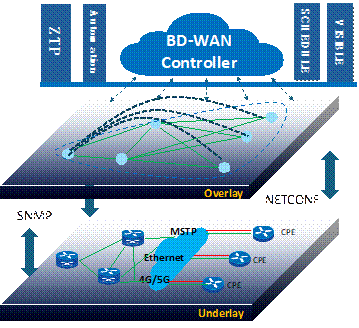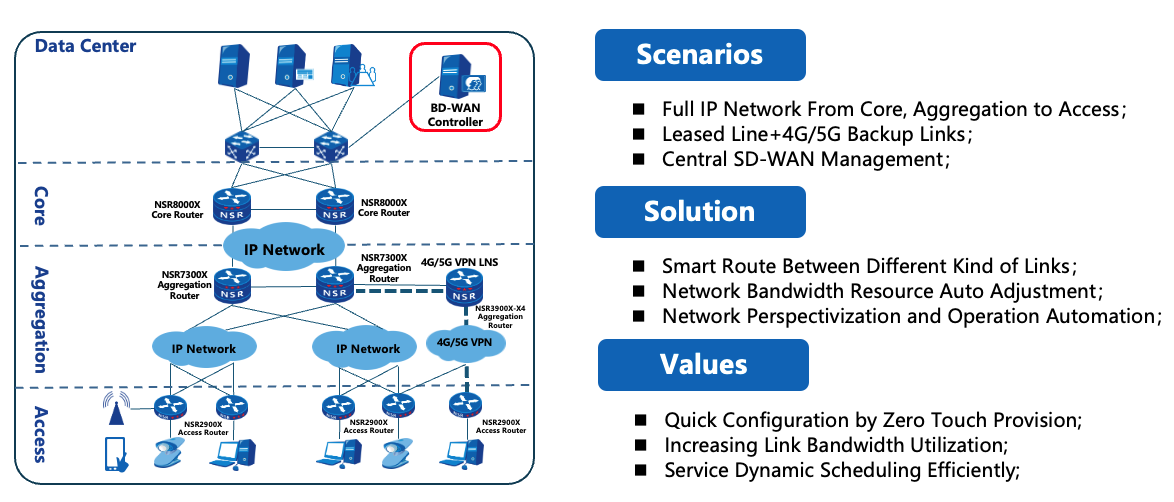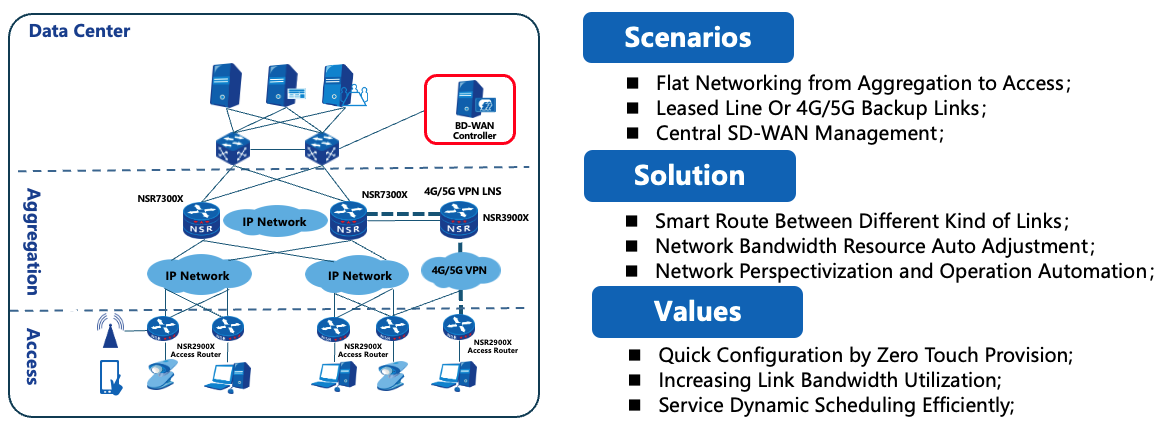Maipu BD-WAN Controller
Maipu software defined WAN solution, referred to as Maipu BD-WAN, is the latest generation WAN solution proposed by Maipu that integrates the core ideas of SD-WAN. This solution is oriented to scenarios such as corporate headquarters and branch access, providing a business experience that is superior to traditional technologies, and meeting many needs such as rapid network service deployment, dynamic traffic scheduling, and network/service visual presentation.
The solution uses DMVPN, the mainstream technology of SD-WAN, to build an overlay logical network to support the smooth migration of traditional WAN networks to SD-WAN. It is suitable for enterprise network scenarios such as banks, government, energy, etc., and meets the needs of next-generation WAN upgrading.
The solution is composed of Maipu BD-WAN controller and routers. Through unified integration of network resources, multi-dimensional observation of network status, and intelligent analysis of operating data, the entire network can achieve multi-level and all-round visualization, and perform centralized control, global scheduling and real-time network optimization based on user policies and business needs. It solves the problems faced by traditional wide area networks such as low degree of automation, low degree of intelligence, invisible network, and high operation and maintenance costs.
Product Features
Solution Key Features
Overlay and Underlay Architecture
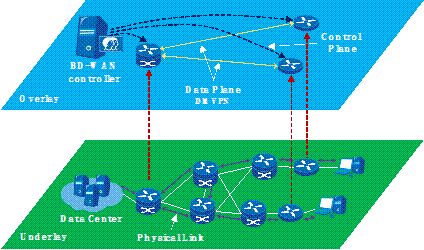
Maipu BD-WAN solution leverages both underlay and overlay network architectures to deliver enhanced performance, flexibility, and control over traditional WAN architectures. Maipu BD-WAN controller supports high availability. If the BD-WAN controller fails, the router will follow the existing overlay rules, but if the links are interrupted at the same time, the router will return to underlay rules. When the controller recovers, it recalculates and delivers the updating overlay rules to the router.
Automatic Deployment
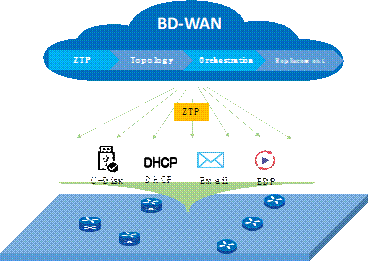
Maipu BD-WAN solution provides a variety of zero-configuration deployment methods to help deployment, operation and maintenance in a simple, fast and efficient manner. The solution supports various zero-configuration deployment methods, such as EDP deployment, USB disk deployment, email deployment, and DHCP deployment, available for different WAN links and scenarios.
EDP deployment is a patented zero-configuration deployment technology developed by Maipu for enterprise network scenarios. Through the cooperation of the controller and the router, the edge router can be automatically scanned and discovered by the central router even if it has the factory default configuration and no IP address. Underlay configurations such as NETCONF, SNMP, and routing protocols can be automatically delivered through the controller, and edge routers can be deployed and online without complex configuration.
Through the zero-configuration deployment tool, automatic deployment of equipment and services can be realized, detailed information of network nodes can be collected and processed in a centralized manner, configurations of network nodes can be distributed, uploaded, and compared remotely, and network node configuration data can be enabled remotely, saving deployment time and reducing the difficulty of deployment. The equipment can be truly plug-and-play, and achieve zero IT operation and maintenance in branches.
Large-Screen Displaying
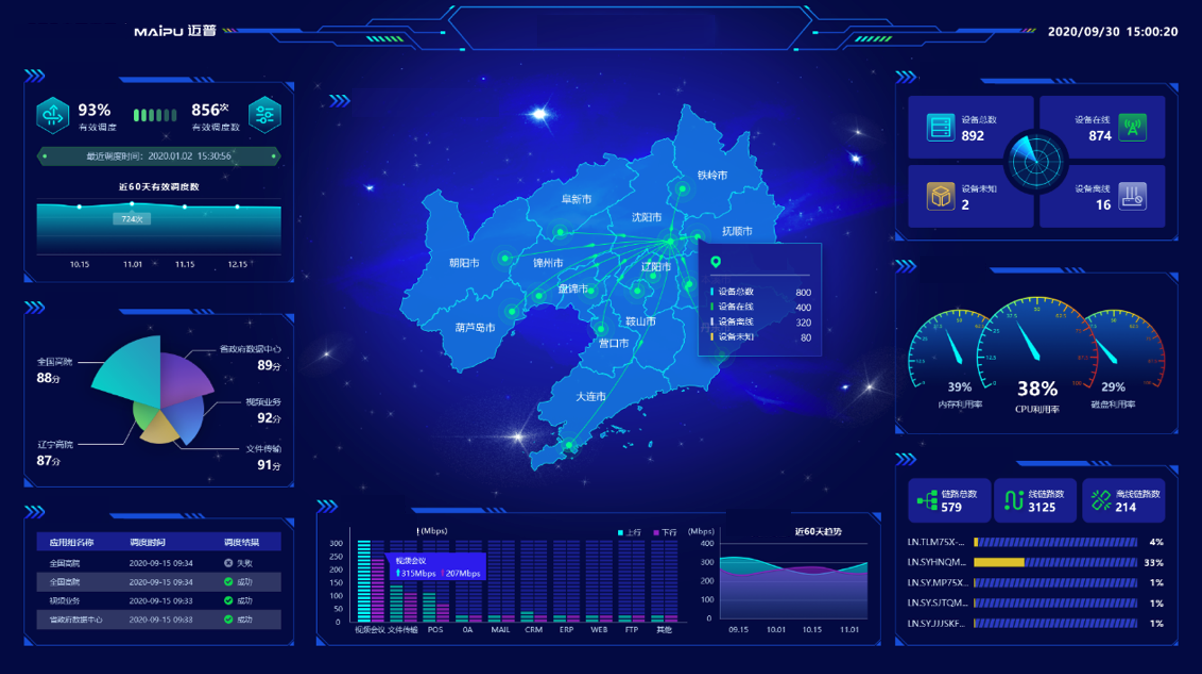
The large-screen component presents the current network status to the user as a whole. It can display the current link operating status, traffic statistics and sorting and other key network information. Through the intuitive display of each site on the WAN map and detailed link status information, allow users to more easily understand the current network operation and link usage.
The information displayed on the large screen including business scheduling times, operating status of the entire network equipment, link bandwidth utilization, link traffic statistics, business traffic statistics, business health status, etc. Through large-screen display, it provides customers with a more intuitive and vivid presentation of network status, and uses intuitive, flexible and diverse charts to provide customers with business-driven decision support.
Entire Network Visualization
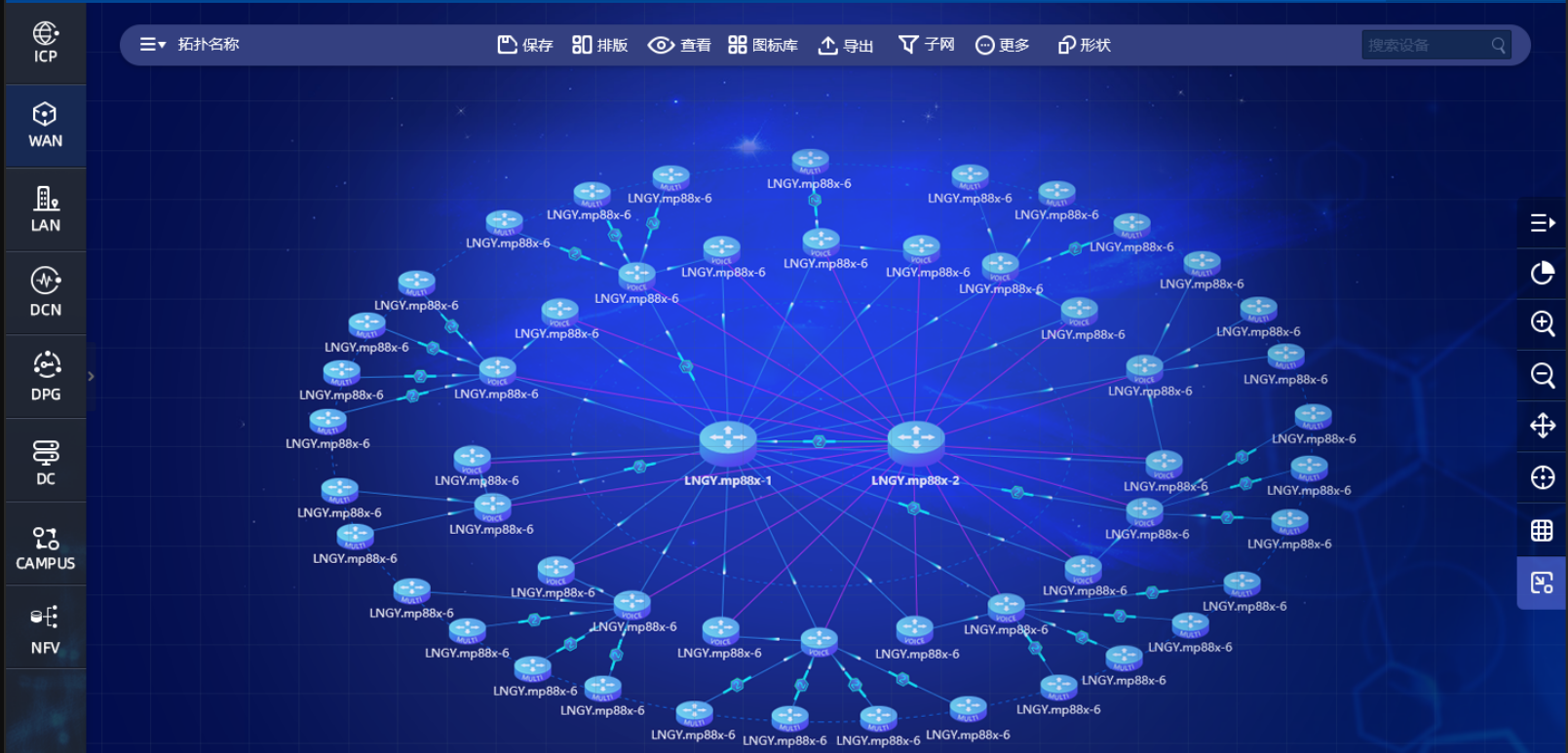
Network visualization: Through the integration of Maipu's patented technology EDP and NETCONF, the three-layer topology is visualized, and the network structure and link information consistent with the actual topology are displayed on the controller; the details of the WAN links in the network can also be viewed, such as bandwidth utilization and line quality.
Path visualization: Through real-time sampling of the network by the controller, the real-time forwarding path of services in the network is presented.
Business visualization: Use network devices as probes to collect traffic information in the network to visualize data flows. Traffic collection can be done at the second level. It supports displaying the traffic information of each application on the controller, including the real-time bandwidth and historical bandwidth of the application, and the bandwidth ratio of the application.
Fault visualization: Real-time collection and alarming of equipment and link status.
Through full network visualization, traditional network nodes and interconnection links in the network can be fully automatically identified and the entire network topology can be constructed. It can clearly grasp the real-time status of every device, every link, and every business, providing necessary conditions for network tuning and troubleshooting.
Business Health Analysis
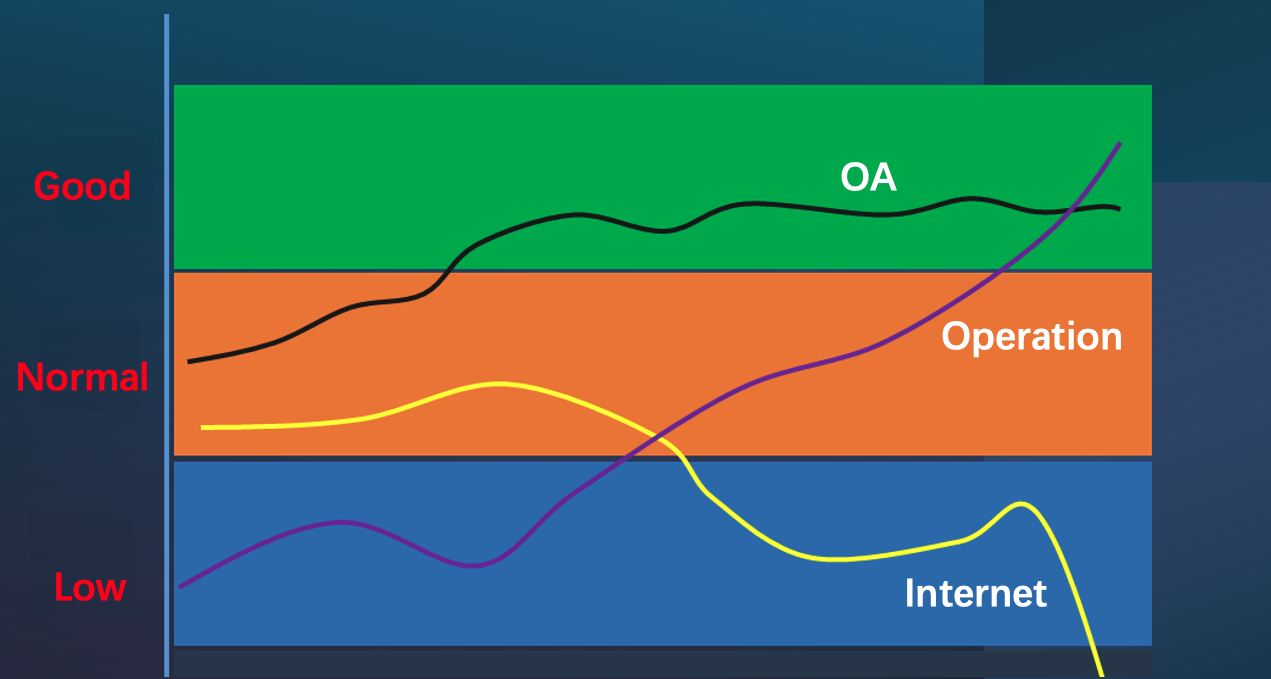
BD-WAN controller can collect and perform statistics on the scheduling frequency, scheduling reasons, and scheduling methods of business flows. Based on the statistical results, analyze the business status, and present the analysis results in the form of scores. It can count the current and total status of the business, rate the health of the business, and give optimization suggestions.
Business health analysis can help customers understand the matching degree of each business under the current network load. Customers can provide decision-making basis for customer network tuning or expansion based on business health ratings and optimization suggestions. The BD-WAN controller can also intelligently predict and schedule sudden business data based on business characteristics to avoid network oscillations.
Intelligent Path Planning
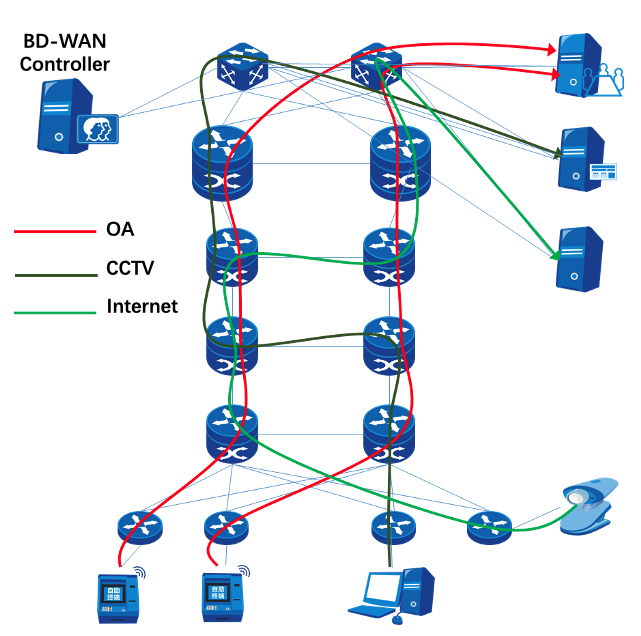
BD-WAN controller can set a dedicated scheduling policy based on the link quality characteristics required for each business operation, and intelligently plan paths. Through real-time detection of the routers of each network node and the link SLA (bandwidth, delay, jitter, packet loss rate, etc.) of the service operation, the controller calculates the link quality of the entire network through rich and flexible scheduling methods. After calculation, deliver the control policy to the corresponding routers, and select the real-time optimal path for business operation.
BD-WAN controller supports rich network models without the need for users to significantly adjust existing network structures. It supports flat networking, multi-level vertical networking, and asymmetric networking. BD-WAN can enable traffic scheduling function based on physical links in wide area networks, and supports dividing different logical networks to schedule business traffic in their respective logical networks. It supports the establishment of tunnel traffic scheduling in sections, supports the establishment of one-section tunnel traffic scheduling, and can also establish one-section or two-section tunnels according to the networking model.
Through intelligent path planning of the entire network, achieve one path for one service, and meet the personalized transmission needs of businesses. In addition, automatic planning of the optimal path reduces the difficulty of business deployment.
BD-WAN Controller Features
|
Software Features |
|
|
Item |
Technical Indicators |
|
Visual operation and maintenance |
Supports large-screen display, displaying the system monitoring components such as scheduling times on the day, application health, scheduling logs, application traffic, etc. |
|
Support network topology display, display device/link connection relationship and link congestion status in the network |
|
|
Support application traffic statistics and display real-time application traffic |
|
|
Support device interface traffic statistics and display device interface traffic |
|
|
Supports application path display, using network equipment as the background and displaying the actual application path in the topology based on business flow direction. |
|
|
Support application health analysis, display application health scores, and display statistics of key events that affect the scores |
|
|
Device management |
Supports rich zero-configuration deployment tools and supports EDP, USB disk, email, DHCP and other deployment methods |
|
Supports automatic delivery of device configuration, and can deliver device configuration remotely through the controller |
|
|
Supports Excel batch import of device configuration. Device configuration can be imported in batches through Excel |
|
|
Supports real-time monitoring of link bandwidth, delay, jitter, and packet loss rate, displaying real-time link quality |
|
|
Support automatic discovery of network topology and automatically draw device link relationships in the network topology |
|
|
Supports unified management and scheduling of Ethernet L2 dedicated lines, L3 dedicated lines, 4G/5G links, and Internet lines |
|
|
Supports one-click replacement of faulty equipment, supports automatic distribution of original equipment configurations to new equipment, and completes the rapid online of new equipment |
|
|
Business planning |
Support creating business network, specify business source and destination nodes, and build overlay networks |
|
Supports application traffic definition based on quintuple and DSCP |
|
|
Supports control protocol message protection to ensure orderly device management when links are congested |
|
|
Supports allocation of link bandwidth through controller interface |
|
|
Intelligent scheduling |
Supports selecting optimal path based on service bandwidth, and can intelligently select the optimal forwarding path for services based on the bandwidth resources of the entire network. |
|
Supports selecting optimal path based on congestion status, adjusting service paths from congested links to idle links, improving link utilization and business service quality. |
|
|
Supports selecting optimal path for link interruption, and adjusts service paths from interrupted links to available links |
|
|
Supports path preemption based on business priority. When the entire network link resources are in short supply, link resources are reallocated based on priority to ensure the service quality of high-priority applications. |
|
|
Supports path planning of the business with the same source and same destination to ensure that business paths are consistent back and forth and avoid traffic being blocked by WAN security devices. |
|
|
Supports selecting the forwarding path that meets the minimum service bandwidth requirement based on the available bandwidth of the link. |
|
|
Supports path calculation based on link delay, jitter, packet loss and other constraints, and select forwarding paths based on business needs |
|
|
Supports triggering path calculation and path optimization based on link policies, and triggers path adjustment after business traffic exceeds the set link threshold. |
|
|
Supports setting constraints for active and standby path switching, such as link delay, jitter, packet loss, etc. When the primary path fails or constraints are reached, traffic is automatically switched to the standby path for forwarding. |
|
|
Supports intelligent scheduling for load balancing based on bandwidth utilization |
|
|
Supports service path optimization, regularly adjusts the path based on initial service quality requirements, recalculates the path after detecting a link failure and restores the optimal service path |
|
|
Supports recalculation and restoration of service paths after equipment failure |
|
|
Supports business scheduling log display, showing the time, reason, result, original path, and final path of business scheduling. |
|
|
High reliability |
Supports dual-network bearer, the overlay network and underlay network are logically isolated, and the service bearer network can be specified according to needs |
|
Supports network escape. After the controller becomes abnormal, it can dynamically adjust the forwarding path according to the real-time network conditions to ensure orderly forwarding of business traffic. |
|
|
Supports dynamic adjustment of node failures. The controller dynamically adjusts service paths according to node conditions to ensure orderly forwarding of business traffic. |
|
|
Management and operation |
Support logging and output functions |
|
Supports direct presentation of fault information in topology diagrams |
|
|
Supports sending alarm information via E-mail |
|
|
Supports alarm threshold setting and supports sending alarms in standard syslog form |
|
|
Supports assigning administrator accounts by branches |
|
|
Support the decentralized and domain-based management functions of the controller accounts |
|
Order Information
BD-WAN Router Position Introduction
|
Position |
SD-WAN Router Model |
Recommend SD-WAN Sites |
Concurrent SD-WAN Flow |
|
BD-WAN Core Router |
MP7500X(SPU40) |
200-400 Sites |
10Mbps/Site |
|
MP7300X(SPU40) |
150-200 Sites |
10Mbps/Site |
|
|
BD-WAN Aggregation Router |
MP3900X(SPU40) |
100-150 Sites |
10Mbps/Site |
|
NSR7300X(SPU05) |
50-100 Sites |
10Mbps/Site |
|
|
NSR3900X-X4 |
1-50 Sites |
10Mbps/Site |
|
|
MP3900X-06 |
1-30 Sites |
10Mbps/Site |
|
|
BD-WAN Access Router |
MP2900X Series |
N/A |
|
|
NSR2900X Series |
N/A |
|
|
|
NSR1900X Series |
N/A |
|
BD-WAN Router Performance Specification
|
Position |
Router |
SD-WAN Router Model |
1:N L3 Link (1400Byte) |
1:N L3 Link (1400Byte + IPSec) |
|
HQ |
SDWAN Core Router |
MP7500X(SPU40) |
4.0Gbps |
2.2Gbps |
|
MP7300X(SPU40) |
4.0Gbps |
2.2Gbps |
||
|
Branch |
SDWAN Aggregation Router |
MP3900X(SPU40) |
3.6Gbps |
2Gbps |
|
NSR7300X(SPU05) |
2.4Gbps |
1Gbps |
||
|
NSR3900X-X4 |
2.2Gbps |
900Mbps |
||
|
MP3900X-06 |
1.0Gbps |
450Mbps |
||
|
Office |
SDWAN Access Router |
MP2900X Series |
300Mbps |
150Mbps |
|
NSR2900X Series |
500Mbps |
200Mbps |
||
|
NSR1900X Series |
500Mbps |
200Mbps |
||
|
Note: 1. The standard service model is used in BD-WAN scenario: DMVPN+PBR+QoS+ ACL+BSM. 2. The advanced service model is used in BD-WAN scenario: DMVPN+PBR+IPsec+QoS+ACL+BSM. |
||||
BD-WAN Controller Introduction
|
Controller Model |
Description |
|
Maipu BD-WAN |
Maipu Business-driven controller platform software |
|
BD-WAN |
Maipu Business-driven functional component license |
|
BD-CLS |
Maipu Business-driven cluster function license |
|
BD-WAN-L-1 |
Maipu Business-driven one node device management license |


